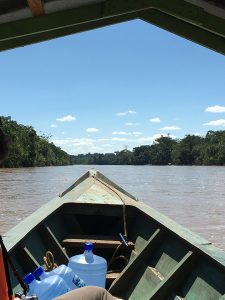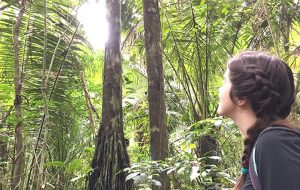[In the photo above, a traditional Peruvian boat plies the waters of a river in the Western Amazon Basin with Virginia Tech students on board, including the author.]
This post is by Carolyn Elliott. Carolyn served as an intern at Vitech in the summer of 2017. She is currently a senior at Virginia Tech, majoring in Industrial and Systems Engineering and planning to graduate in May of 2019. Her previous post with us was Improving How Lawn Mowers are Made at John Deere. For another post about conservation and systems thinking, see The Power of Systems: Wolves Change the Course of Rivers.
“Conservation must be treated as a system.” So states Dave Johnston, founder of an ecotourism and conservation nonprofit that seeks to protect the incredibly biodiverse Amazon rainforest. I met Dave last summer, as part of a student service trip that he led in the Peruvian Amazon.
As a student of Industrial and Systems Engineering, I was intrigued by the idea that systems thinking could be applied to conservation issues.
But let me back up. My trip began in June, when I flew to Peru as part of a student service organization at Virginia Tech called VT Engage.
After two plane flights (DC – Lima; Lima – Puerto Maldonado) and a five-hour boat ride, we arrived at Las Piedras Amazon Center (LPAC), part of ARCAmazon, the Alliance for Research and Conservation in the Amazon, an ecotourism and conservation nonprofit. The center consists of an outdoor kitchen and dining area and several platforms for sleeping scattered throughout the nearby rainforest. Our platform was made out of wood and raised several feet above the ground, in order to protect us from any animals such as jaguars that might walk through camp. There was a recycled tarp roof over our heads that would shield us from the rain, as well as a mosquito net surrounding each bunk bed. Those were our only protections from the jungle: a raised platform, a tarp roof, and a mosquito net.
I expected to be scared out of my mind—which I was!—but I truly did not expect to feel so at home by the end of my week there. We formed close bonds with the researchers and other employees at the center. We also got to know the people at a nearby village, Lucerna Community, as well as other researchers at another ecotourism/conservation camp upstream. I learned to enjoy my new vegetarian diet, and, upon waking up, the sound of monkeys in the distance. I also learned that one has to spray insect repellent on the inside of your clothes as well as on the outside—pesky insects have an uncanny way of getting inside your clothes and staying there for repeated bites.
So, how can systems thinking help efforts to conserve the Amazon?
Dave notes on the ARCAmazon website that he is “passionate about systems where humans and nature benefit from one another in balance.” There are a few things to note in this statement. First, that conservation must be treated as a system. Second, that humans and nature are the subsystems. And lastly, that the balanced interaction of these subsystems is the key to an effective solution. I was able to see firsthand how these concepts were put into action.
Let’s focus first on the subsystem of nature. Its role in the context of this system is pretty obvious. The Amazon rainforest is the most biodiverse ecosystem in the world. It is home to more than 5 million species of plants and animals. The Amazon also produces approximately 20 percent of the world’s oxygen supply, demonstrating its undeniable value. Clearly, conservation of the rainforest is important.
This bring us to our next subsystem: humans. This is the element that is often overlooked in the fight to preserve the Amazon. The people who call the Amazon home probably have the greatest impact on it. Many people rely on the rainforest for a living, which is certainly not a bad thing on its own. Timber extraction is a lucrative business. The trees are abundant and can be sold for large amounts of money. When you think about it, this is something every country does: sell its natural resources. Once the land has been cleared, it can serve another purpose to produce income, such as raising livestock and farming. The land is incredibly fertile, and the weather is perfect for growing plants like cocoa, the bean used to make chocolate.
The issue with these practices arises when they are no longer sustainable, such as cutting down trees faster than they can grow back. This causes animals to be displaced since they rely on these trees for shelter and cover. It also means that the rainforest produces less oxygen—a harmful outcome.
There’s another important component of the human subsystem: the conservationists. Conservationists are seemingly at odds with farmers and timber extractors. This is where the systems perspective comes into play. Dave has built strong relationships with nearby communities in order to create solutions that work for both parties. Ecotourism and the jobs it creates can also provide a sustainable income for the Amazon’s inhabitants in a way that does not harm the natural resources.
ARCAmazon recognizes the delicate balance between preserving the rainforest and allowing the people who live there to use their home and its resources to make a living.
The organization further contributes to preservation through its interaction with nature directly. This includes conducting research. Scientists use video traps to watch and study the behavior of animals that live in the rainforest. This information is used for educational and conservation purposes. Additionally, timber extractors are not allowed to cut down trees on LPAC land. In this way, ARCAmazon protects the land from further harm. This interaction of people and nature contributes immensely to conservation.
Taking a systems approach, I believe, is truly the only way to find a sustainable solution that balances the needs of the two subsystems—humans and nature. It is through interactions within these subsystems and between the subsystems that the greater system, conservation, finds a balanced solution.
One more thing—when you do travel to the Amazon, don’t forget to bring along a few extra cans of insect repellant.




